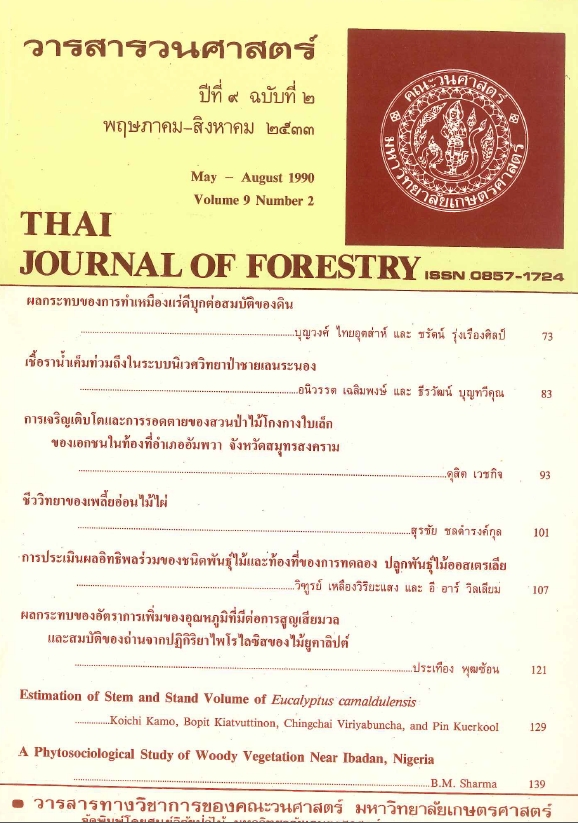ผลกระทบของการทำเหมืองแร่ดีบุกต่อสมบัติของดิน
Main Article Content
บทคัดย่อ
การศึกษาเรื่องนี้มีจุดประสงค์เพื่อทราบถึงผลกระทบของการทำเหมืองแร่ดีบุกต่อสมบัติทางกายภาพ และทางเคมีของดินบางประการ โดยได้เก็บตัวอย่างดินชั้นบน 63 ตัวอย่าง จาก 7 ชั้นอายุหลังการทำเหมือง ชั้นอายุละ 3 บริเวณ บริเวณละ 3 หลุม ตัวอย่างดินทั้งหมดเก็บจากที่ดินซึ่งผ่านการทำเหมืองแร่ไปแล้ว 1-20 ปี ของบริษัท ไทยอุตสาหกรรมการเกษตรสากล จำกัด ท้องที่อำเภอท้ายเหมือง จังหวัดพังงา ผลการวิเคราะห์พบว่าดินเป็นทรายจัด เป็นกรดจัด และมีปริมาณธาตุอาหารพืชอยู่น้อยมาก โดยจําพวก sandy loam ระดับ pH ต่ำกว่า 5 ปริมาณฟอสฟอรัส และแคลเซียมจัดอยู่ในระดับต่ำมาก หากแบ่งที่ดินภายหลังการทำเหมืองแร่ออกตามสภาพภูมิประเทศเป็น 3 บริเวณ ก็พบว่าดินบริเวณลานทรายมีความอุดมสมบูรณ์น้อยที่สุด แม้บริเวณกองกรวด และดินเลน รวมทั้งที่ดินซึ่งผ่านการทำเหมืองแร่มานานถึง 20 ปี จะมีอนุภาคดินเหนียวและปริมาณธาตุอาหารพืชเพิ่มขึ้นบ้างก็ตาม แต่ก็ยังไม่อุดมสมบูรณ์พอที่จะใช้เพื่อการเกษตรให้ได้ผล ดังนั้น การปรับปรุงดินเหมืองแร่เก่าจึงเป็นสิ่งจำเป็นอย่างยิ่ง เพราะการปรุงเปลี่ยนแปลง โดยธรรมชาตินั้นต้องใช้ระยะเวลายาวนานมาก
Downloads
Article Details

อนุญาตภายใต้เงื่อนไข Creative Commons Attribution-NonCommercial-NoDerivatives 4.0 International License.
ข้าพเจ้าและผู้เขียนร่วม (ถ้ามี) ขอรับรองว่า ต้นฉบับที่เสนอมานี้ยังไม่เคยได้รับการตีพิมพ์และไม่ได้อยู่ในระหว่างกระบวนการพิจารณาตีพิมพ์ลงในวารสารหรือสิ่งตีพิมพ์อื่นใด ข้าพเจ้าและผู้เขียนร่วม (ถ้ามี) ยอมรับหลักเกณฑ์และเงื่อนไขการพิจารณาต้นฉบับ ทั้งยินยอมให้กองบรรณาธิการมีสิทธิ์พิจารณาและตรวจแก้ต้นฉบับได้ตามที่เห็นสมควร พร้อมนี้ขอมอบลิขสิทธิ์ผลงานที่ได้รับการตีพิมพ์ให้แก่วารสารวนศาสตร์ คณะวนศาสตร์ มหาวิทยาลัยเกษตรศาสตร์ กรณีมีการฟ้องร้องเรื่องการละเมิดลิขสิทธิ์เกี่ยวกับภาพ กราฟ ข้อความส่วนใดส่วนหนึ่ง หรือ ข้อคิดเห็นที่ปรากฏในผลงาน ให้เป็นความรับผิดชอบของข้าพเจ้าและผู้เขียนร่วม (ถ้ามี) แต่เพียงฝ่ายเดียว และหากข้าพเจ้าและผู้เขียนร่วม (ถ้ามี) ประสงค์ถอนบทความในระหว่างกระบวนการพิจารณาของทางวารสาร ข้าพเจ้าและผู้เขียนร่วม (ถ้ามี) ยินดีรับผิดชอบค่าใช้จ่ายทั้งหมดที่เกิดขึ้นในกระบวนการพิจารณาบทความนั้น”


